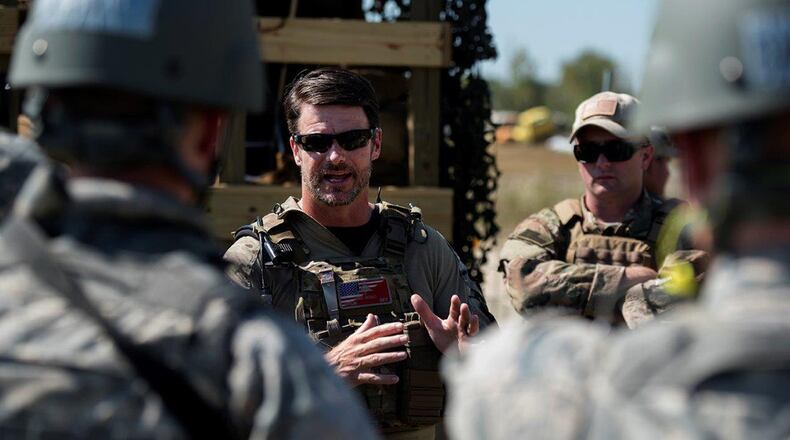This is exactly what the 50 or so participants in AFRL’s Tech Warrior 2017 exercise did from Sept. 19-29 at the National Center for Medical Readiness at Wright-Patterson Air Force Base when they were immersed in a home station deployment exercise as technology warriors.
The event, which in previous years, had been attended by scientists and engineers from AFRL for the most part, was open to military and civilian personnel from throughout AFMC locations across the country. The opportunity gave the participants, from Airmen through GS-15 personnel, a chance to walk in the shoes of today’s battlefield Airmen.
“Tech Warrior has two objectives,” said Lt. Col. David Shahady, Tech Warrior exercise commander. “First, we want to teach our participants what it is to be a warfighter. We run them through a series of training and events just to have them walk in the shoes of the warfighter. At the same time we’re doing all that, we bring out technologies and try to push innovation and see how those technologies would work in a real warfighting environment.”
During the 11-day immersion, participants receive training in such areas as field operations, combat first aid, rescue operations, perimeter defense and basic weapons familiarization in a realistic operational environment. After five days of training, a three-day capstone field training exercise enabled participants to test their skills with a focus on combat rescue, disaster response and airbase defense.
Between 20 and 30 technologies were integrated into the exercise, several of which have been developed by small businesses working with the Air Force through the Air Force Small Business Innovation Research program, including six companies from the Dayton regional area.
“One was a sweat-sensing technology from a company called Eccrine Systems, who are developing technology with the Air Force to collect sweat and determine whether somebody has become dehydrated,” Shahady said.
During the 2016 rendition of Tech Warrior, 10 participants experienced dehydration issues, which affected exercise scenarios.
“This year we had no issues whatsoever because we were able to monitor participants real-time and see when someone was actually becoming dehydrated and pull them to rehydrate themselves. Going from 10 people who had dehydration issues to zero is very exciting and a really good demonstration of our technology maturing,” Shahady said.
Shahady explained that there are so many things going on the world right now that the idea of handing battlefield Airmen the most advanced equipment possible is critical.
“We can accelerate technology by doing this kind of research in an operational environment with the warfighter. We have to be able to move at the speed of everything going on around us, so it is that much more important that our innovation cycle get considerably faster,” he said.
Both younger and more seasoned military and civilian personnel participated in Tech Warrior 2017, providing the exercise even more realism and diversity.
“I signed up wanting to experience what it was like in a mock deployment setting and to see the types of technology that people from different labs are working on,” said 1st Lt. Joel Atienza, from AFRL’s Information Directorate in Rome, New York.
“I’ve actually experienced more than I thought I would – I got to ride in HUMVEES, participate in mounted defense operations and dismounted urban operations,” he said.
Atienza said he also experienced really cool technologies, which surprised him because his experience so far with the Air Force has centered only around computer-related technology.
“The instructors really wanted us to have a mindset that this was real, and that made the experience more effective overall,” said Atienza, a two-year Air Force member who has not yet experienced his first real operational deployment.
He arrived at the beginning of the exercise as a second lieutenant, but received a pleasant surprise when his team leaders announced during a briefing that Atienza was receiving a “field” promotion to first lieutenant.
“It was really cool that they built my promotion into the exercise scenario script. I was quite honored by that,” he said.
Cathy Thompson, a production manager with the 421st Supply Chain Management Squadron at Tinker Air Force Base, Oklahoma, learned of the Tech Warrior exercise from an email that came through her organization. The 32-year Air Force civil service employee said she was really glad she received permission to attend.
“This has exceeded all my expectations,” she said. “They’ve exercised us as accurately as possible in a training environment. We’ve had the full field conditions experience here. This is my first opportunity to see how a deployment is, and I wanted to come and see what the warfighter actually goes through while they’re down range. Now I can go back and support the idea of others coming here to support AFRL in testing these new technologies.”
For Thompson, one of the best parts of the experience was gaining a better understanding of the battlefield airman mentality, which will ultimately enable her to better perform in the technology support environment.
“I think everybody, when they first get hired by the Air Force should participate in a simulated deployment like this. It would help you get a better understanding of why that person needs that part, why they need a certain type of helmet, why they need whatever they need, you will have a better understanding after walking a mile in their shoes,” she said.
About the Author
